This book by a Class 47 aficionado illustrates a large variety of locations where Brush Type 4 Class 47 locomotives were seen during their more than sixty years of service on Britain’s railways, and the many liveries they carried during the later years in mainline service.
Published in November 2023 by Amberley Publishing and written by Martin Measures, this soft cover book measures around 16.5 cm x 23.4 cm, and has 96 pages and 180 illustrations. It has a published price of £15.99, but at the time of writing, it can be purchased for £14.39 from Amberley Publishing and for £12.29 from Amazon.
It becomes clear from a nine-page introduction that the author has long held a great fondness for the Class 47s as he describes his quest to view and ride behind them, especially during the twilight years of their front-line service.
The author’s enthusiasm shines through in the captions, as they extend way beyond the usual “what, where, and when” that often accompanies books of this nature. Most captions extend to five or six lines. As well as extensive details about the locomotives and workings photographed, additional background information about the trains and their locations makes the book stand out from the ordinary.
In a book covering a single class of locomotive, it is often the case that after a few pages, interest wanes as the photos seem to be a case of déjà vu. Thankfully, that is not the case with Martin Measures’ book, as he has gone to great lengths to ensure that the photos on each pair of pages provide a balanced view of their workings and liveries.
With the author being born in the year the first of the class rolled off the production line, his dedication to following the Class 47s has given him plenty of opportunity to photograph these locomotives, with the images in his book being a fine sample of both his and fellow photographers’ output.
It is always welcome in a book dedicated to a particular class of locomotives to see photographs of them in settings rather than on operational duties. This is the case on the left-hand page below, where at the top early members of the class are seen in the paint shop at the Brush works at Loughborough, while below a fellow class member is being given a wash and brush up.
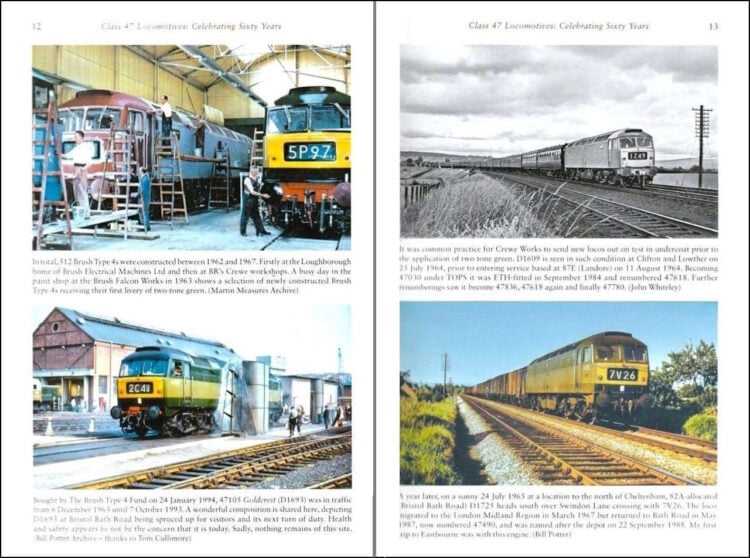
For many of their sixty years of service, Class 47s were always seen in the ubiquitous BR Blue livery such as seen below. These photographs stand out by the author including plenty of infrastructure interest, especially at the bottom-right with the magnificent signal gantry at Taunton.
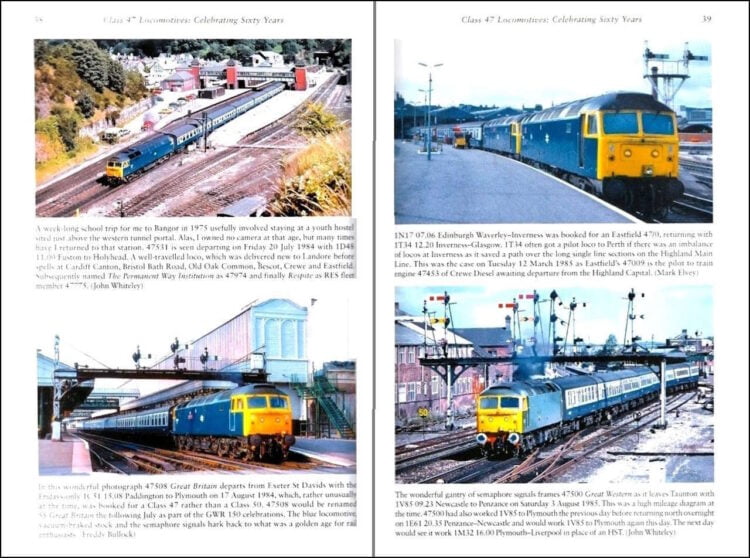
Once the monopoly of BR Blue had been broken, then opportunities abounded to photograph Class 47s in a host of different liveries. Mention should be made of the locomotive shown at the top right which is in what became the corporate standard for Network Southeast.
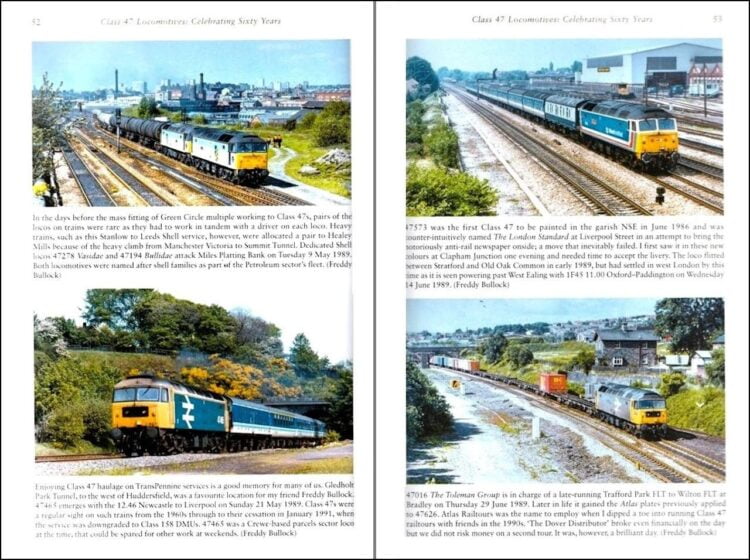
After BR Blue had been consigned to history, many Class 47s adopted the livery shown at the top left, which greatly contrasts with the example below. Once they started to be withdrawn, many were purchased by private buyers, such as the one shown at the bottom right in the livery of music producer Pete Waterman’s Waterman Railways.
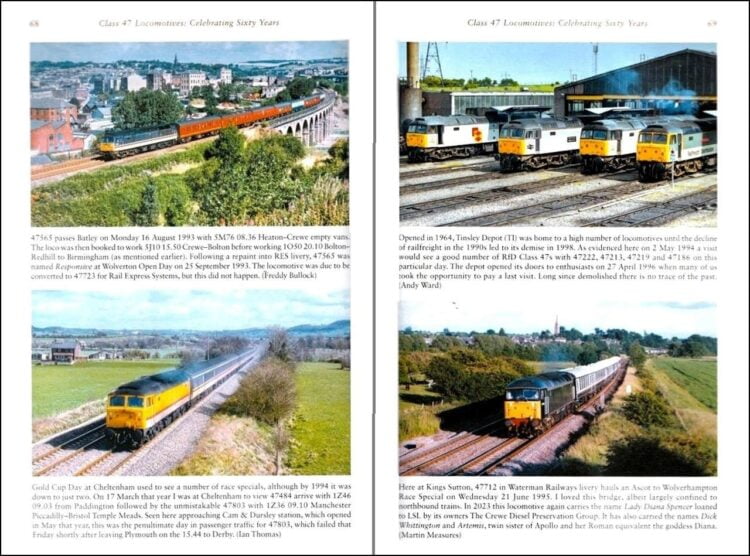
A striking example of the different liveries can be seen in the photos below, especially the one at the top right in a unique “Police” livery.
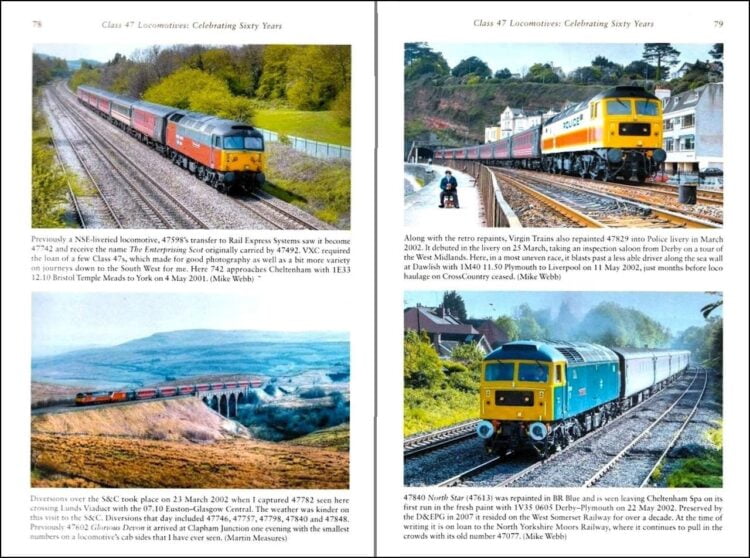
Written by an author whose enthusiasm for the Class shines through on every page, this book provides an excellent cross section of the class on operational duties and in different liveries.
Excellent captions accompany the photos, and are clearly written by someone who has a great knowledge of their subject. They invariably extend way beyond the usual brief “what, where, and when” details that often accompanies books of this nature. Most captions extend to five or six lines, and as well as extensive details about the locomotives and their trains, additional background information provide a pleasing addition.
From beginning to end there is no lack of interest, especially in the Introduction which provides an interesting background into what became the author’s lifetime interest in the class.
The selection of photographs has been well chosen to maintain the reader’s interest, with examples of most of the different liveries in their later years on front-line services, but unfortunately they are often lacking in clarity.
The book is a fitting tribute to the over sixty years of the Brush Type 4s, but as is usual in similar books from this publisher the book is not divided into sections, neither is there an index.
The book is available to purchase from Amazon and from Amberley Publishing.
We would like to thank Amberley Publishing for providing us with a copy of the book for review.





Responses